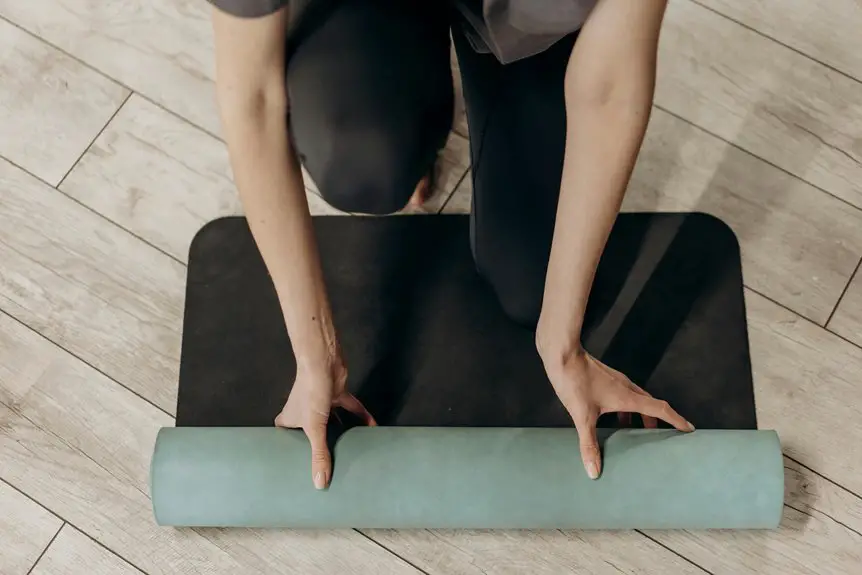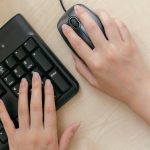To position your trackball mouse for maximum comfort, keep it at or just below elbow level to maintain a neutral arm posture. Your palm should face down or slightly tilted, and forearms should be parallel to the ground. Relax your grip and use your fingers for rolling the ball, minimizing large hand movements. Make sure your chair supports your lower back, and your monitor is at eye level to prevent strain. Discover more tips to enhance your workspace ergonomics!
Table of Contents
Key Takeaways
- Position the trackball mouse at or just below elbow level to maintain a neutral arm posture and reduce strain.
- Keep your forearm parallel to the ground while using the trackball to minimize unnecessary movement.
- Relax your grip on the trackball and use your fingers for precise control instead of moving your entire hand.
- Ensure your chair supports your lower back, allowing your feet to rest flat on the floor for optimal posture.
- Adjust your monitor height to align with eye level, preventing head tilt and promoting comfort during use.
Understanding the Ergonomics of Trackball Mice
When you consider using a trackball mouse, it's essential to understand its ergonomic benefits. Unlike traditional mice, trackballs allow you to keep your hand stationary while you roll the ball to navigate. This can reduce wrist strain and promote a more natural hand position.
You'll find that your arm remains relaxed, which minimizes fatigue during long hours of use. Additionally, trackballs often require less desk space, making them ideal for smaller work areas.
The design encourages a more neutral wrist posture, which can help prevent repetitive strain injuries. By choosing a trackball, you're investing in a tool that not only enhances comfort but also boosts productivity.
Ideal Height and Angle for Your Trackball Mouse
To ensure optimal comfort and efficiency while using your trackball mouse, it's crucial to adjust its height and angle appropriately.
Ideally, your trackball should sit at or just below elbow level. This positioning helps maintain a neutral arm posture, reducing strain on your shoulders and wrists.
The angle of your trackball should allow your hand to rest comfortably, with your palm facing down or slightly tilted. Experiment with small adjustments to find what feels best for you.
Remember, your forearm should remain parallel to the ground, minimizing unnecessary movement. A well-positioned trackball encourages fluid motion, enhancing your overall productivity.
Take the time to find the right setup, and you'll enjoy a more comfortable and efficient experience.
Hand Positioning Techniques for Better Control
Finding the right hand positioning can greatly enhance your control over the trackball mouse. Here are some techniques to help you achieve better precision:
- Relax Your Grip: Keep your fingers gently resting on the trackball rather than gripping it tightly. This helps reduce fatigue and allows for smoother movements.
- Use Your Fingers for Navigation: Instead of moving your entire hand, rely on your fingers to roll the ball. This will improve your accuracy and response time.
- Maintain a Neutral Wrist Position: Ensure your wrist is straight and comfortable. Avoid excessive bending, as this can lead to strain and discomfort over time.
Adjusting Your Workspace for Comfort
Creating a comfortable workspace is essential for maximizing your trackball mouse experience.
Start by ensuring your chair supports your lower back and allows your feet to rest flat on the floor. Position your desk at a height that lets your elbows stay close to your body while keeping your forearms parallel to the ground.
Place your trackball mouse within easy reach, ideally at or slightly below elbow height, to minimize strain. Adjust your monitor to eye level, so you don't have to tilt your head up or down.
Lighting should be adequate to reduce glare, and consider using a wrist rest to keep your hands comfortable.
These adjustments will help you maintain a more relaxed posture while using your trackball mouse.
Testing and Tweaking Your Setup for Optimal Use
Once you've established your workspace, it's time to test and tweak your setup for optimal use.
Start by ensuring your trackball mouse is positioned comfortably within reach, allowing for natural wrist movement. Next, assess your screen height; your eyes should align with the top third of the monitor. Finally, don't forget to adjust your chair height for proper posture.
Here are three key areas to focus on:
- Mouse Sensitivity: Experiment with different DPI settings to find what feels best for you.
- Button Customization: Map frequently used functions to your trackball buttons for efficiency.
- Breaks: Schedule regular breaks to stretch and prevent fatigue.
Fine-tuning these elements can make a significant difference in your comfort and productivity.
Frequently Asked Questions
Can I Use a Trackball Mouse With My Left Hand?
Yes, you can use a trackball mouse with your left hand. Just ensure it's designed for left-handed use or adjust your grip comfortably. Experimenting with different positions will help you find what feels best for you.
Are Trackball Mice Suitable for Gaming?
Yes, trackball mice can be suitable for gaming. They offer precision and reduce wrist strain, allowing quick movements. However, you might need to adjust your gaming style to maximize their benefits and enhance your gameplay experience.
How Do I Clean My Trackball Mouse?
To clean your trackball mouse, unplug it, remove the ball, and use a soft cloth to wipe the interior. Rinse the ball with water, dry it thoroughly, and reassemble. You're good to go!
What Are the Benefits of Using a Trackball Mouse?
Using a trackball mouse offers precision, reduces wrist strain, and saves desk space. You can navigate smoothly without moving your arm, making it ideal for tight workspaces or long hours of computer use.
How Long Does It Take to Adjust to a Trackball Mouse?
It usually takes you a few days to adjust to a trackball mouse. You'll gradually develop muscle memory, improving your precision and comfort. Give yourself time, and soon you'll find it feels natural and intuitive.




